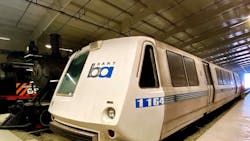BART delivers first of three decommissioned legacy fleet cars to Western Railway Museum
Bay Area Rapid Transit (BART) has delivered the first of three decommissioned legacy fleet cars to the Western Railway Museum (WRM) for its forthcoming Rapid Transit History Center.
The museum was awarded the three retired cars – an A, B and C car – following a call for proposals in 2021 that selected eight recipients to receive decommissioned cars (two recipients later declined). BART officially retired its legacy fleet, which carried passengers for more than 50 years since the opening of the system, at a ceremony and final ride in April 2024. All 55 trains in service are now made up of new cars.
According to the agency, the chosen six groups who will receive the decommissioned cars will reuse their cars for a multitude of purposes, including a short-term rental in the Sierras, a bike shop and clubhouse for Oakland, Calif., youth, a dining car with retro arcade games and more. The Hayward Fire Department picked up their car earlier this year for its new Regional Fire Training Center.
BART notes when deciding who to choose to award the decommissioned cars to, the agency made it clear it would give the cars to the groups for free but the groups had to transport the cars from their temporary home at BART’s Hayward shops to their final destinations.
The agency notes each car weighs 64,000 pounds. To move the cars requires a flatbed truck with a yellow “OVERSIZE” banner, as well as a crane for getting the car off the bed. Moving just one car costs thousands of dollars.
The WRM raised money to make sure they could get the cars to their new temporary home in Car House 3 until their proposed Rapid Transit History Center is completed. The history center will educate the public about BART and its history of innovation. In addition to the three cars, which the public will be able to enter and explore, the center will include displays, videos, a set of wheels from the front of a cab car, third rail equipment and the antennas that enable the train to pick up power and communicate with train control.
"The creation and implementation of cutting-edge technologies began with BART's visionaires understanding the great challenge to design a new transit concept. They were not unlike the visionaries who went on to build Silicon Valley," said Bob Simon, a retired BART engineering and operations manager who sits on the WRM's Board of Directors.
